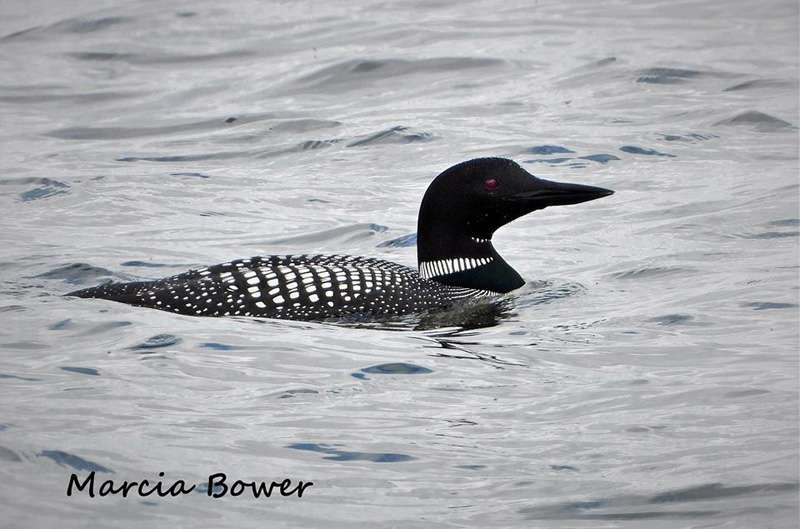by Robert Gang

Photo by Marcia bower
Every spring, Oneida Lake residents are treated to a parade of migrating waterfowl. While I enjoy seeing the hooded, red-breasted and common Mergansers, Buffleheads, Scaup and American golden-eyes, my favorite visitor is the common Loon.
While I've never heard its loud shrill cry on Oneida Lake, just seeing the Loon on a misty spring morning 70 yards offshore gives the feel of a secluded bay on a lake in the north woods.
A large bird, the Loon can be up to 32 inches long with a 32-inch wingspan. The common Loon is easily distinguished from the Mergansers, with which it may be confused, by its long straight heavy black bill, black head and neck with greenish gloss, and black back checked with white.
In the past, before the advent of motorboats, it was common for migrating Loons to linger on Oneida Lake until the end of May. About the only good thing that I can say about the spring flood of '93 is that we were able to enjoy the extended stay of five Loons that spent a lot of time foraging for minnows and shrimp in front of my house.
These Loons stayed in the area longer than usual this year because of the boat moratorium that was in effect during early May. I never thought about it before, but I believe that the Loons move on to their breeding grounds on opening day of walleye season.
The Atlas of Breeding Birds in New York State suggests that in 1986, there was possible breeding in North Bay, NY. Loons usually lay their two eggs close to the water's edge in late May or early June. I have been informed that a pair was sighted in Briggs Bay as late as the 1st week of June. It's possible that these birds were breeding in this area. On the other hand, the Adirondacks are only a few hours away as the Loon flies. This pair may have been seen during their last few days on the lake. I would be interested in hearing any reports of Loons seen this summer.
The Loon's nest of loose plant material is built close to the water's edge, as this bird is practically helpless on land. Its strong, powerful legs are set so far back on its body that the Loon is unable to walk. However, this arrangement allows the Loon to swim very fast for long distances underwater in search of fish. One study reports that a fish was taken from a net placed 200 feet underwater!
The Loons' eggs are dark brown spotted with black, are 3.5 inches long and 2.2 inches wide. Incubation starts when the first egg is laid, and lasts about 29 days for both the female and the male.
The young are covered with dark gray down when hatched, and are able to eat whole fish and crustaceans when only 1 day old. They are able to swim within a few days and sometimes will ride on the back of the parent. Adult plumage is attained after 3 years.
If you are out boating in the spring and see some Loons on the water, please admire them from a distance. They are shy birds and will move on north to their nesting grounds if harassed. While they do eat some of our fish, they are worthy of every protection for the feeling of wilderness that they give to the lake in the spring.
Reprinted (with minor modifications) from The Oneida Lake Bulletin: Fall, 1993

